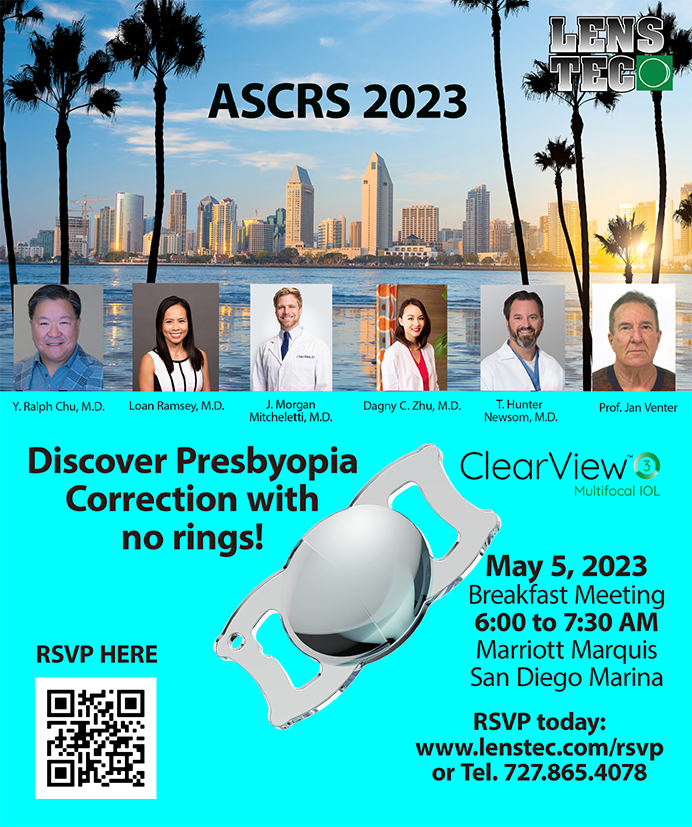Watch It Now

For the full content of BMC’s November 2015 interview with Brett Saunders, visit http://bit.ly/1P2o2VX.
During the American Academy of Ophthalmology Annual Meeting in November, Allergan President and CEO Brent Saunders spoke with BMC about a variety of topics, including Allergan’s growing eye care portfolio, drug pricing, his philosophy on research and development (R&D), and his personal and professional goals. One large topic remained off-limits, however: the pending blockbuster merger with Pfizer. Just a week after that interview, Pfizer and Allergan officially announced that they had entered into a definitive merger agreement to combine in a stock transaction valued at about $160 billion. The takeover, which is expected to close in the second half of 2016, would be the biggest deal ever in the health sector. It was announced that Mr. Saunders would serve as the president and chief operating officer of the combined company.
In a subsequent exclusive interview with BMC, Mr. Saunders spoke about the deal and specifically what it potentially means for the future of Allergan’s eye care business and operations.
BMC: Following the announcement of the merger, you said that Pfizer will expand the reach of Allergan’s established portfolio by using its existing commercial capabilities, infrastructure, and vast global footprint. How do you believe Pfizer will help the existing high-growth therapeutic areas that Allergan is currently in? How does the combination increase the ability to develop drugs and get them onto the market?
Mr. Saunders: The way I think about it is [that] one of our most important goals is to get our medicines and therapies to patients around the world. Today, we do that in roughly 60 markets around the world. Pfizer does it in roughly 160 markets around the world. So, this transaction will enable us to significantly expand our international presence and very quickly begin to bring medicines to people in 100 countries in the world that we don’t currently sell our products in.
That has enormous opportunity for physicians and patients around the world to get the access, not only to our current portfolio, but also to the drugs that are coming in our pipeline. Ultimately, I think that’s a real win for physicians, eye care professionals, and patients.
BMC: At a Forbes summit in December, you said one of the benefits of the merger, in addition to Pfizer’s R&D capabilities, is that some of the applications from Pfizer’s specialties such as oncology may be used to develop new molecules in Allergan’s existing portfolio such as ophthalmology. Can you discuss how you believe Allergan’s current portfolio can benefit from Pfizer’s current offerings?
Mr. Saunders: At Allergan today, we employ a strategy called “Open Science.” In eye care, we have some discovery capabilities, and we also have deep development capabilities in eye care. Under the proposed merger with Pfizer, at closing, we would have significant discovery capabilities. Some of those exist today in areas like oncology or [central nervous system] that could have application to eye care R&D, but they also could be just investing in building more capabilities—to complement existing Allergan discovery capabilities.
I really do think that this particular transaction could be a huge win for the eye care community in that you could see Allergan go even deeper into investing in R&D for unmet need in eye care.
BMC: You have a long-term relationship with the eye care community, and you have said that you would like to continue to pursue opportunities for growth in this field. At the Ophthalmology Innovation Summit prior to the Pfizer merger’s being made official, you touted the 17 products currently in Allergan’s eye care pipeline. Taking an objective view of the eye care market in the near and long term and under the large umbrella of Pfizer, how big a focus will eye care be under the combined company? Do you feel ophthalmology presents a long-term opportunity for financial growth for the new Pfizer?
Mr. Saunders: Yes, I think ophthalmology and eye care will be a top therapeutic area for the combined company. We will be a global leader in eye care. We will have a deep commitment to eye care. I think you’ll see that—almost like you saw with the Actavis-Allergan merger where we took a company with a deep history and commitment to eye care and tried to elevate our game with respect to our commitment to medical education, science, and product development—I think you’re going to see that happen again and perhaps even be a larger step in support of the eye care community.
Eye care is a terrific area of medicine. Ophthalmologists and optometrists are fantastic practitioners. The new combined Allergan-Pfizer will be, as I said, a world leader, and there’s still so much unmet need. [There are] still so many people that are suffering for either known reasons or unknown reasons, and ultimately, where I’d like to see us go is from not just treating disease but curing disease. I think this combination puts the new Pfizer, the combined Allergan-Pfizer, in a position to start the dialogue around cures versus just treatment.
BMC: Will eye care be treated as its own unit under the combined company?
Mr. Saunders: It’s a bit early to say with certainty what the structure will look like, but Pfizer today operates under what are called global business units or GBUs, as they call them. Under that construct, eye care would become a global business unit and more or less run independently.
BMC: Pfizer stated that it anticipates the transaction will deliver more than $2 billion in operational synergies over the first 3 years after closing. I know it’s still early in the process and a lot of the details are still being worked out, but what can you tell me about how the current operations at Allergan will be affected, and will the ophthalmology operations continue to be located in Irvine, California?
Mr. Saunders: Yes, again, it’s a bit early to say with any certainty, but it would be very sensible to keep our eye care business centered or headquartered in Irvine, California. We would certainly keep our R&D capabilities for eye care in Irvine. While there are real synergies in $2 billion, we’d generally be looking for areas of overlap, and eye care is not an area of overlap. Outside of some R&D programs and experience in eye care, Pfizer currently doesn’t have any real commercial capabilities in eye care. So, there may be a few things that have to change, but I would analogize this to the Actavis-Allergan combination, where you didn’t see a lot of changes and you didn’t see a lot of synergies come out of the eye care team.
BMC: I wanted to ask something related to the Actavis-Allergan deal. One of the things I think a lot of the medical professionals in the ophthalmology market appreciated is the fact that Allergan retained its name following that merger. I know that it was announced that the combined company will be called Pfizer PLC, but what will become of the Allergan name? Will it remain a unit or a brand of Pfizer, or will it be eliminated?
Mr. Saunders: I think, at this early stage, anything is possible. Obviously, I understand and appreciate the value of the Allergan name, and so we will study it and do it very thoughtfully. Clearly, the company will be called Pfizer PLC, but if there’s an opportunity to preserve the [Allergan] name for good reason, I’m very open-minded to that.
BMC: In recent years, Allergan has introduced some devices, particularly in the aesthetics business. However, Pfizer is more of a traditional drug company. Do you see the possibility for the new combined company to add devices to its portfolio?
Mr. Saunders: I don’t think our strategy will change with respect to eye care as it exists today. As you know, as of late, we have moved into devices with both the XEN45 stent and the Oculeve dry eye device. We will continue to look for ways to solve for unmet need, whether it be drug or device. Obviously, we need to do things that we’re good at. Capital equipment, for example, hasn’t been an area where we’ve had tremendous experience, but if ultimately there’s an opportunity to better serve our customers and solve for unmet need through capital equipment, we would be open to that as well.
BMC: There has been a lot of discussion on a national scale about the issue of tax inversion, and many politicians have weighed in. Some are using this deal as an example of the need for tax reform, with the goal of keeping companies, and the taxes they pay, in the United States, but in an op-ed that recently appeared in USA Today, you and Ian Read made the case that the Pfizer-Allergan deal is good for America and [that] the combination will expand your ability to invest in the United States.1 Can you expand on how you believe the deal is good for the United States?
Mr. Saunders: Yes, the combined company will have roughly 40,000 employees in the United States. We will invest the vast majority of close to a $9 billion R&D budget in the United States, and under the international tax regime, we believe we can sustain those levels of investment in doing important work in the United States. And so, we are not trying to avoid paying our taxes. The new combined company will pay all the taxes on the profits it earns in the United States. This is about putting ourselves in a competitive position, not being double taxed on foreign profits, and being able to reinvest in America without having to pay additional taxes to do things like R&D and employ 40,000 people.
BMC: Finally, as you know, a lot of innovation in ophthalmology is the result of long-term relationships between industry leaders and medical professionals, but there is some concern that, as more of the traditional ophthalmic companies such as Bausch + Lomb, Alcon, and now Allergan are becoming part of much larger companies, some of those long-term relationships, and thus the deals and innovation that come from those relationships, could be in jeopardy. What would you say to this?
Mr. Saunders: I would say it has nothing to do with whether or not these companies are part of larger companies or stand-alone companies. I think it goes to attitude and focus and priorities inside a company. I think you’re absolutely right; to be effective in eye care and some other specialty therapeutic areas, you need to be in tune with your customers. You need to understand what they need to better serve patients. You need to get their perspective on innovation and science. You need to understand where they see unmet need. Whether you’re a big company, small company, or part of a multinational company, it’s about your commitment and how you want to live up to that commitment. In my new role in this combined company, I will be 100% committed to the eye care community and making sure that we continue to improve upon our relationships with industry in a compliant, lawful way but also in a very meaningful way.
1. Read I, Saunders B. Pfizer-Allergan: good for America. USA Today. December 1, 2015. http://usat.ly/1IKxhZz. Accessed December 7, 2015.


